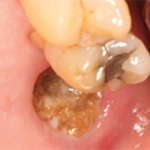The Wnt signaling pathway also has antagonists that stop bone formation; one is Dickkopf-1 (DKK-1). In the presence of synovial inflammation, fibroblast-like synoviocytes stimulated by tumor necrosis factor (TNF)-a produce DKK-1, which then stops new bone formation around the area of inflammation. At the same time, DKK-1 reduces the production in preosteoblasts of OPG, so that osteoclasts are stimulated to mature and resorb bone. Therefore, with synovial inflammation like that which occurs in RA, DKK-1 production may reduce bone formation and increase bone resorption. Treatment of TNF transgenic mice with anti–DKK-1 and an anti-TNF blocking agent reduced joint destruction.10,11 Interestingly, patients with active RA have also been shown to have increased serum levels of DKK-1.
Because TNF stimulates DKK-1 production, anti-TNF agents used to treat RA patients with active joint inflammation may reduce TNF-a and, most likely, DKK-1. As a result, patients may have less structural deterioration and possibly some healing of bone loss. The investigations linking the Wnt signaling pathway with bone and joint destruction in RA are fascinating, reminding us that the most important way to prevent structural deterioration in our patients is by reducing joint inflammation. We can accomplish this goal with aggressive anti-TNF blocker use, which can improve bone mass structure around the inflamed joints and also change the biochemical markers of bone turnover toward formation rather than resorption.
Because bone resorption is increased in patients with RA, investigators have always wondered if a potent anti-resorptive agent could reduce the development of new bone erosions. Recently, two studies addressed these questions.
In the first, patients with active RA were randomized to intravenous zoledronic acid or placebo. After six months, patients treated with the bisphosphonate has a significant reduction in new erosions as assessed by MRI.12
In the second study, patients with active RA taking methotrexate were randomized to placebo (60 mg) or 180 mg of a monoclonal RANKL inhibitor (denosumab). Denosumab use reduced new bone erosions seen on MRI at six months and significantly reduced new erosions shown on radiograph after 12 months.13 Potent reduction in osteoclast activity caused by new agents may prevent structural deterioration in RA patients. However, neither bone active agent reduces joint inflammation (the main source of the osteoclasts that create erosions). At present, the most important treatment strategy for erosion prevention targets joint inflammation because data indicate that TNF blocking agents that reduce joint inflammation can also reduce new joint erosions very effectively. Future studies should provide new information on the effect bone-active agents have on both local and generalized both loss in inflammatory disease and whether these agents can promote healing as well as prevent damage.
Conclusion
During the last 10 years, clinicians have been able to identify patients at risk for osteoporotic fractures. Potent anti-catabolic agents and anabolic agents—either used alone or sequentially—are effective in preventing incident fractures and treating established disease for both postmenopausal osteoporosis and glucocorticoid-induced osteoporosis.

